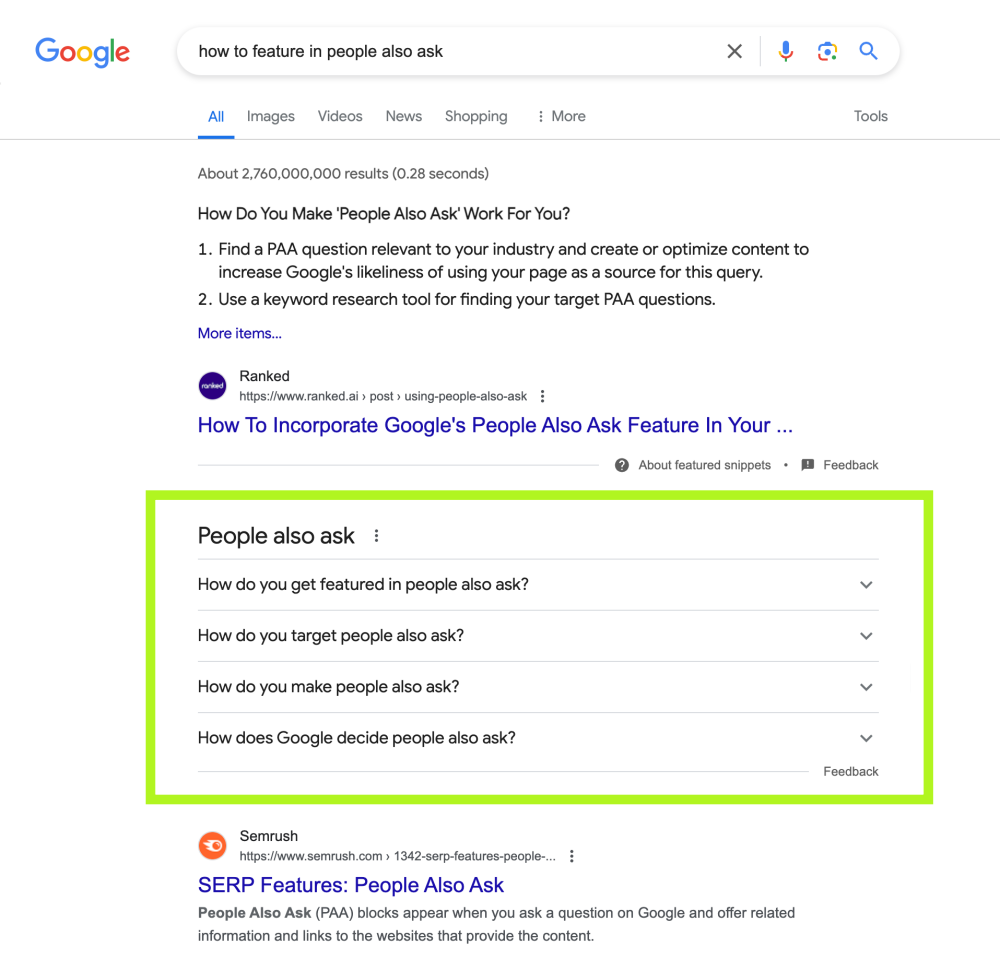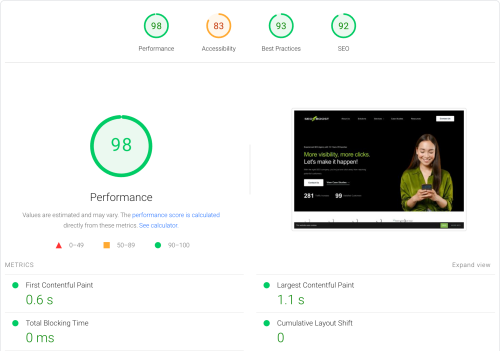What is “People Also Ask”?
Imagine you’re a content writer searching for the best way to get your content featured in “People Also Ask” (PAA) boxes. Along with websites on topics related to “People Also Ask,” Google displays a box titled “People Also Ask.” This box is filled with questions others have asked about optimizing content for PAA, from the best strategies to how Google determines which questions to feature. Each question expands to reveal a brief answer and a link to the source website. It’s like a quick Q&A session that broadens your understanding of the topic without the need to sift through pages of information.

Common Types of PAA Questions
1. How-To Questions
These are practical, step-by-step queries where users are looking for guidance on how to accomplish a specific task. They often start with “How to” and are focused on providing actionable instructions. For example:
- How to tie a tie?
- How to make banana bread?
2. Definition Questions
These questions seek a clear and concise explanation or definition of a term, concept, or subject. Users asking these questions are typically looking to expand their knowledge or clarify their understanding. Examples include:
- What is blockchain technology?
- What is gluten?
3. Comparison Questions
Such questions involve comparing two or more items, services, concepts, or entities to understand their differences, similarities, advantages, and disadvantages. They often include words like “vs,” “compare,” or “difference.” For example:
- iPhone 12 vs. iPhone 13: What’s the difference?
- Buying vs. leasing a car: Which is better?
4. Why Questions
These inquiries delve into the reasons or causes behind a particular phenomenon, decision, or fact. They seek to satisfy users’ curiosity about why something is the way it is. Examples might be:
- Why do leaves change color in the fall?
- Why is the sky blue?
5. What-If Questions
These speculative questions explore hypothetical scenarios, often involving conditions or outcomes. They can range from practical to imaginative queries. For instance:
- What if the internet stopped working?
- What if I invest in stocks?
6. Location-Based Questions
These are queries tied to a specific geographic location or seeking information about places. They might involve directions, local services, or features of a particular area. Examples include:
- What are the best restaurants in New York City?
- Where is the nearest gas station?
7. Product or Service Specific Questions
These questions are directly related to products or services, often seeking detailed information about features, uses, or suitability. For example:
- Which laptop is best for graphic design?
- What services do digital marketing agencies offer?
Why Is The PAA Feature So Useful?
Is Optimizing Your Content for "People Also Ask" Worth It?
Certainly, even though research indicates that only about 3% of users actually click through from “People Also Ask” (PAA) boxes to the featured websites, optimizing your content for PAA remains a valuable strategy. Here’s why:
1. Visibility Beyond Clicks
The 3% click-through rate doesn’t fully capture the visibility and brand recognition that comes with appearing in PAA. Just being seen in these boxes can reinforce your brand’s presence in users’ minds, making it more likely they’ll think of you when they need services or products you offer.
2. Establishing Authority
Being featured in PAA answers signals to users that your brand is a trusted authority in your niche. Over time, this perception builds credibility and trust, which are invaluable for long-term brand loyalty.
3. Strategic Content Alignment
By aligning your content with the questions and answers featured in PAA, you’re directly addressing the queries your target audience is actively searching for. This relevance enhances the user experience and positions your content as particularly valuable and informative.
4. Competitive Advantage
Securing a spot in PAA answers can give you a significant advantage over competitors who aren’t featured, drawing user attention and interest toward your brand and away from others.
5. Effective Reputation Management
Even if users don’t click through, seeing your brand provide answers for critical questions—especially those directly related to your products or services—helps control the narrative around your brand and maintains a positive image.
How To Optimize Your Content for PAA
1. Pinpoint the Perfect Content for PAA
2. Fine-Tune Your Content for PAA Spotlight
Being featured in PAA means your content appears right at the top of Google’s first page. Achieve this by:
- Providing Accurate Answers: Ensure your responses are factual and trustworthy.
- Keeping It Brief Yet Complete: Offer concise answers that fully address the question.
- Staying Specific: Showcase your expertise with detailed, specific answers.
- Aligning with Search Intent: Remember, users seek informative answers, not sales pitches.
Content that’s optimized for featured snippets often gains traction in PAA, doubling your chances of visibility.
3: Integrate PAA Questions Seamlessly
Use PAA questions as headings in your content, immediately followed by a succinct answer. If the question requires a more elaborate response, start with a brief answer and then expand. However, always ensure the PAA integration feels natural and enhances the reader’s experience.
4. Adapt to the Evolution of Search
With Google’s advanced algorithms like BERT and MUM, there’s a greater focus on content relevance over keyword repetition. Trust that Google will recognize the relevance of your content to the PAA questions, even if the keywords aren’t an exact match.
5. Leverage FAQ Schema Markup
Make your content more accessible to search engines by using FAQ Schema markup. This code snippet in your webpage’s source helps Google understand that your content is structured as a Q&A, making it easier for your answers to be featured in PAA.
To Wrap Up
Securing a spot in Google’s “People Also Ask” (PAA) boxes can significantly boost your search engine visibility. While you can spot PAA questions directly on search engine results pages (SERPs), a comprehensive approach to keyword research is essential to discover more PAA opportunities. Additionally, having a solid understanding of on-page optimization is key to making the most of these opportunities.
At SEOBoost, we’re adept at identifying potential PAA questions and fine-tuning your content to optimize for them. If you’re aiming to feature in Google’s SERP features like “People Also Ask,” let us lend you our expertise. Reach out to SEOBoost to enhance your digital footprint.


![The Ultimate On-Page SEO Checklist for 2024 [Template Included]](https://seoboost.io/wp-content/uploads/2024/06/Social-Thumbnail-–-The-Ultimate-On-Page-SEO-Checklist-for-2024-Template-Included.jpg)



